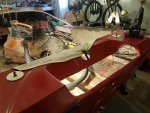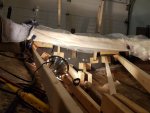I'm replacing the stringer, front bulkhead, and possibly some marine foam in the floor of an old 1970s Baja speed boat (best guess is model SS16, year 1976-1978). I've attached a photo of the boat as I'm not 100% sure of the model or year.

Does anyone have design plans or photos of what the structural stringers and bulkheads are supposed to look like for this boat (or a similar model). The previous owner replaced the floor and I'm not sure if what I'm looking at is reflective of the original design of the boat (see photos below). He may have removed some foam, bulkheads, and definitely redesigned the ski-bar attachment. With these changes, I'm unclear on the 1) way the deck floor (plywood) is supposed to be attached to the inner-hull fiberglass floor running up and down the sides, 2) whether there is supposed to be more bulkheads, 3) how the ski bar attachment support was originally constructed, and 3) length of hull lined with foam.
I've removed the floor and removed the rotten front bulkhead (3/4' plywood), and plan to remove the single center stringer, as it is also rotten. I also removed foam (looks to be about 2 lbs/cuft) that was strongly adhered to the stringer and hull. The foam only seemed to be installed under the floor deck 1/3 of the way from the front bulkhead (under steering wheel) toward the back of the boat, but I'm not sure if it originally covered the entire stringer length back to the bilge area.


Regardless whether someone can provide original design plans for this boat, I'm looking for advice on how to reconstruct the structural support for this boat. I plan to replace the front bulkhead and centre stringer, but I’m unclear on what to do from that point on. The main questions I have are: 1) is it better to reinstall the foam along stringer and V-hull under floor, or instead install additional bulkheads every 3-4 feet down the length of the hull, or both; 2) how should I reattach the inner-hull fiberglass floor that runs along the sides to the center plywood floor (not shown) – should I epoxy this inner-hull fiberglass floor to plywood floor AND to the main hull (i.e., should I join the hulls)?
I'm a newbie, so bare with my ignorance please.
Thanks,
Chris
Does anyone have design plans or photos of what the structural stringers and bulkheads are supposed to look like for this boat (or a similar model). The previous owner replaced the floor and I'm not sure if what I'm looking at is reflective of the original design of the boat (see photos below). He may have removed some foam, bulkheads, and definitely redesigned the ski-bar attachment. With these changes, I'm unclear on the 1) way the deck floor (plywood) is supposed to be attached to the inner-hull fiberglass floor running up and down the sides, 2) whether there is supposed to be more bulkheads, 3) how the ski bar attachment support was originally constructed, and 3) length of hull lined with foam.
I've removed the floor and removed the rotten front bulkhead (3/4' plywood), and plan to remove the single center stringer, as it is also rotten. I also removed foam (looks to be about 2 lbs/cuft) that was strongly adhered to the stringer and hull. The foam only seemed to be installed under the floor deck 1/3 of the way from the front bulkhead (under steering wheel) toward the back of the boat, but I'm not sure if it originally covered the entire stringer length back to the bilge area.
Regardless whether someone can provide original design plans for this boat, I'm looking for advice on how to reconstruct the structural support for this boat. I plan to replace the front bulkhead and centre stringer, but I’m unclear on what to do from that point on. The main questions I have are: 1) is it better to reinstall the foam along stringer and V-hull under floor, or instead install additional bulkheads every 3-4 feet down the length of the hull, or both; 2) how should I reattach the inner-hull fiberglass floor that runs along the sides to the center plywood floor (not shown) – should I epoxy this inner-hull fiberglass floor to plywood floor AND to the main hull (i.e., should I join the hulls)?
I'm a newbie, so bare with my ignorance please.
Thanks,
Chris





























